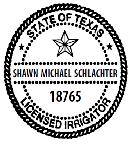Tips to improve your water use
(Written with summer in mind but good advice throughout the year, especially remember to water well before a freeze and when it has been cold and dry for an extended period.)-R.L.
By MARK BOWEN Urban Harvest-Originally published June 15, 2008 Mark Bowen is a local author and the projects director for Urban Harvest. This column is produced by Urban Harvest. To find out more about community gardens, school and youth programs, classes and farmers markets, visit www.urbanharvest.org.
It’s that time of year when some of our plants start to struggle a bit as our weather gets hotter and drier. Several questions have come in recently about watering practices, so here are some suggestions. For the Greater Houston area, I still recommend a fairly old-school approach to determine how deeply and frequently to water.
How long to water – In terms of determining duration, I recommend watering each area once per season (especially the first year) to the saturation point with whatever form of manual or automatic irrigation you normally use. Log the results in a journal. What you are trying to do is soak the soil in each area of your landscape to the point that water begins to run off to other areas or pool quite a bit. Time how long it takes to reach the supersaturated soil point, then when you water in the future, back the time down by five minutes per section to avoid runoff.
How often to water – Next, when you are trying to determine how frequently to water there are a couple of considerations. Start by observing your plants and seeing if they are wilting or not, you will have a pretty good idea if your individual plants are getting enough water. When plants wilt, at first they are trying to reduce the amount of leaf surface exposed to the sun. But when pronounced wilting occurs, damage has already been done to the plant. If just one or a few plants out of many are wilting continuously in a specific area, it might make sense to move them to other wetter sections of your landscape or to replace them with more drought-resistant alternatives at some point. Then, get in the habit of periodically checking soil moisture levels a few inches down. The rule of thumb for most soils and plants is to water on average when the soil has about as much moisture content as a well-squeezed sponge. For most plants, if the soil moisture level gets to the bone dry stage, damage has already occurred to the plant.
One major reason not to keep the soil continuously moist is that oxygen in the soil will be displaced by water, creating anaerobic soil conditions that tend to favor disease-causing microbes (pathogens) over disease-fighting beneficial microbes that favor aerobic soils. A second reason is that overwatering contributes to imbalanced plant growth (usually top growth at the expense of root growth). With most plants if a natural balance between root growth and shoot (top) growth does not occur, then pest, disease and/or inadequate drought resistance problems typically follow at some point.
Quick guide based on Temp –R.L.
- Below 60 degrees once per week unless it has be particularly dry.
- Below 70 degrees twice per week
- Below 80 degrees 3 times per week
- Below 98 every other day unless you see plant wilt.
- Above 98 or if very dry every day
Group your plants–Over the long haul, it pays to group and zone your plants according to their water requirements. For example if you have sections of your landscape that tend to stay wet, you might want to consider grouping bog-loving plants in that section to create a rain garden. Rain gardens involve grouping plants that enjoy moisture and tolerate poor drainage together in water retentive sections of your landscape. These wet areas could occur naturally, or you could create them to harness rainwater for use in the landscape and to prevent other areas from flooding. Once you have grouped water needy plants together, moderate water-needy plants together and drought-tolerant plants together (and match them up as well based on light requirements, size, aesthetic considerations and other functional considerations), then it will be easier to water effectively and efficiently.
Consider an irrigation system– If you have an existing irrigation system, consider having it reconfigured based on water requirement-oriented plant groupings. This approach can save an enormous amount of money over the long haul, since it will allow you to water each area only as much as needed. By contrast, most people end up determining how much to water based on a few plants per zone (area) that need more water than the other plants. This approach leads to most plants being overwatered and unnecessary water use.
I know it sounds cliché, but with irrigation you will save enormously by watering based on the needs of the many, rather than the needs of a few. Move or replace the few.
Fortunately new and improved versions of micro-irrigation (low volume irrigation systems) are showing up on the market with quality components. Check out the WaterSmart Program’s Web site for some excellent information on L.V.I. (low volume irrigation) from Angela Chandler.
“Low-Volume Irrigation (LVI) has been called by many names since its introduction to the market; “trickle irrigation”, “drip irrigation”, “micro-irrigation”, “micro-misting”, “low-pressure irrigation”. The term “low-volume irrigation” reinforces the idea of responsible water usage.”
There are many ways to get water to plants. The most efficient and productive are regular rains. Since plants seem to respond to rainwater better than anything else supplemental watering is often referred to as “life support” for plants. But in Houston we can count on lots of supplemental watering during certain seasons and during most years.
Hand-held hose watering is a relaxing and pleasant garden chore when compared to many other garden duties. However, hand watering can waste a lot of water and can be very time-consuming for a gardener with lots of area to cover.
Soaker hoses work well, but are real water guzzlers in our soils. They must be placed fairly close together, or must be left on for long periods of time to soak a large area. Many times the area directly under the soaker hose is water logged, while the outer zone of the area is barely damp. In addition, soaker hoses are not “garden remodeling” friendly. It will take two people to safely remove and re-lay soaker hoses in an established bed if the needs of the garden change or the hose becomes damaged.
—Watering should be done during the early morning hours to avoid fungus development— R.L.
Questions, contact us at www.ravenscourt.us or gardens@ravenscourt.us












